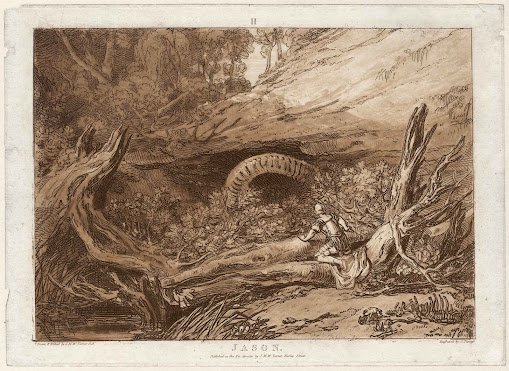(Etcher) Joseph
Mallord William Turner (1775–1851)
(Engraver) Charles Turner
(pseudonym: Renrut) (1774–1857)
“Jason”, 1807, from the series,
“Liber Studiorum”, published in Part I by JMW Turner in London.
Mezzotint and etching printed
in a brown ink on laid paper (presumably Auvergne paper made by T Dupuy [see
Finberg p. 1xxvii]) with a narrow margin around the plate mark and backed with
a support sheet.
Size: (sheet) 21.3 x 29.5 cm;
(plate); 21 x 29.2 cm; (image borderline) 18.4 x 25.9 cm.
Lettered on plate above the
image borderline: (centre) "H".
Lettered on plate below the
image borderline: (left) “Drawn & Etched by J.M.W. Turner R. A.”; (centre) “JASON./
Published as the Act directs by J.M.W. Turner Harley Street.”; (right) “Engraved
by C. Turner”.
State i/ii (of v) with “Marginal
line at right and other lines imperfectly bitten” before the second state
showing “Marginal line completed. … Margins cleaned” (Finberg pp. 23–24). The
state may however be from the second state as the initial (“H”) is no longer an
open letter (i.e. it is filled in).
Finberg 6; (Alexander J Finberg 1988, “J. M. W. Turner’s Liber Studiorum with a Catalogue Raisonné”, San Francisco, Alan Wofsy Fine Arts, pp. 21–24, cat. no. 6).
The British Museum offers the
following description of this print:
“On the right, Jason climbs
over broken tree-trunks in the foreground towards a cavern in the rock in which
a coil of a serpent is seen emerging”
(https://www.britishmuseum.org/collection/object/P_1900-0824-10).
The Tate Gallery offers the
following explanation of the portrayed subject based on JMW
Turner’s painting of the same title (see URL below):
“Jason was a Greek hero,
challenged to bring home from Colchis a golden fleece belonging to a marvellous
ram. Here, Jason is seen stealing up on a dragon which he must outwit to gain
the fleece.
The hero’s courage is
emphasised by the way Turner suggests, rather than shows, the size and ferocity
of the dragon. A single coil of its body emerges from the deep shadow, while
the bones of previous human victims are scattered in front of its lair”
(https://www.tate.org.uk/art/artworks/turner-jason-n00471).
Condition: a richly inked early impression showing no sign of wear to the printing plate. The sheet is trimmed close to the platemark with chips to the margin edges and laid onto a support of archival (millennium quality) washi paper.
I am selling this exceptionally
rare early impression of an important print in Turner’s oeuvre, for AU$433
(currently US$319.81/EUR267.08/GBP239.65 at the time of this listing) including
Express Mail (EMS) postage and handling to anywhere in the world, but not (of
course) any import duties/taxes imposed by some countries.
If you are interested in
purchasing this superb etching showing Turner’s amazing creative invention—note, for example, his use of a latticework of lines to create shadow at the lower left—and imagination to suggest the awesome might of the
dragon lurking in the cave by showing only a section of its arching tail,
please contact me (oz_jim@printsandprinciples.com) and I will send you a PayPal
invoice to make the payment easy.
This print has been sold






















































